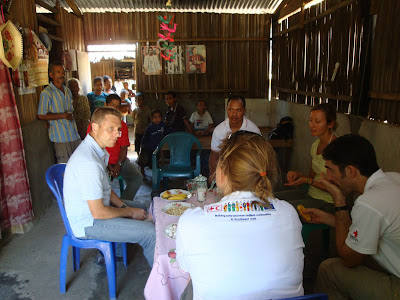Dili, Timor-Leste, 16 July 2009
 Their eyes swelling with tears, the four men dressed in traditional costumes take turns sipping the local tua-sabu wine from the same glass as multitudes of clansmen, women and children witnessing the ceremony cheer them on. When the glass is empty, the men representing each of the aldeias or villages in the locality embrace one another emotionally as the clapping and chanting in the crowd reaches a crescendo.
Their eyes swelling with tears, the four men dressed in traditional costumes take turns sipping the local tua-sabu wine from the same glass as multitudes of clansmen, women and children witnessing the ceremony cheer them on. When the glass is empty, the men representing each of the aldeias or villages in the locality embrace one another emotionally as the clapping and chanting in the crowd reaches a crescendo.
“We want to put an end to the ugly chapter in our history that was full of confrontation and begin a new era of renewed friendship and sustainable peace,” says Jose dos
The symbolic ceremony was held on 9 July, 2009 at the chilly and serene hilltop of Durulete, located some 60 kilometers west of the country’s capital, Dili. It was organized by the Strengthening Institutional Structure and Mechanisms for Dialogue, or as it is simply known, the Dialogue Project, implemented by the Ministry of Social Solidarity (MSS) and the United Nations Development Programme.
It is a bottom-up and grassroots version of diplomacy. Activists, who are close to affected communities, drive the all-inclusive dialogue process. “Dialogue teams can only facilitate face to face talks, but true genuine peace and reconciliation can only come from the people themselves,” says Helder do Rego, a Dialogue team leader instrumental in facilitating the successful Durulute peace talks. He is a member of one of the eight four-person teams spread across the country, based in Baucau, Ermera and Dili, who play a catalytic role in organising the discussions.
The April/May 2006 crisis was the latest in a cycle of conflict that displaced thousands of people, undermining prospects of peace and stability in
Echoing a common theme during the dialogue ceremony, Paulo Assis Belo, the vice-minister for Education recalled the thousands of people martyred during the struggle for the country’s independence, saying that the living have a duty to “honor the dead by living in peace.”
“Party politics should not split families, clans and communities.” He said, stressing the issue “should not make you kill each other.”
It’s a message that seems to resonate quite well in the aldeias and sucos of Timor-Leste, some of which were theatre of deadly confrontations, pitting youths--- and martial arts--- groups against each other.
Buoyed by the success of the dialogue effort, experts say it needs to be formalized as a conflict-resolution mechanism. “There is need to institutionalize dialogue within the communities,” reckons Jose Belo, the Dialogue Project Manager. Recounting his experience, Jose says that the dialogue process also has to be nuanced, in recognition of different social structures prevailing in the country. “In Dili, for example, the process is a bit formal while in the rural areas like Durulete, we rely more on traditional mechanisms.”
 Inevitably, it’s not always smooth-sailing. For instance, in the suco Camea area of Becora, located in the outskirts of the city, a dialogue ceremony attended by the President of the Republic, Jose Ramos-Horta on 23 April 2009, ended in a stalemate after rival parties failed to reconcile, despite concerted efforts by a plethora of local activists, NGOs and the Government to bring them to the talking table. Ramos-Horta, a Nobel Peace Prize laureate personally chaired the talks, showing the commitment of the country’s leadership in resolving the problem of internally displaced people (IDP), in partnership with all stakeholders. Through the continuing support of the UNDP/MSS dialogue teams and a network of non-governmental actors the Camea dispute has since been amicably addressed, with the return and reintegration of the IDPs in that area being a symbolic victory following a very protracted process.
Inevitably, it’s not always smooth-sailing. For instance, in the suco Camea area of Becora, located in the outskirts of the city, a dialogue ceremony attended by the President of the Republic, Jose Ramos-Horta on 23 April 2009, ended in a stalemate after rival parties failed to reconcile, despite concerted efforts by a plethora of local activists, NGOs and the Government to bring them to the talking table. Ramos-Horta, a Nobel Peace Prize laureate personally chaired the talks, showing the commitment of the country’s leadership in resolving the problem of internally displaced people (IDP), in partnership with all stakeholders. Through the continuing support of the UNDP/MSS dialogue teams and a network of non-governmental actors the Camea dispute has since been amicably addressed, with the return and reintegration of the IDPs in that area being a symbolic victory following a very protracted process.
The dividends of dialogue meetings go beyond talking about peace. Being a popular forum attended by a wide cross-section of the population, the event provides an ideal setting for Government officials to explain development policies to the people in the characteristic Town-Hall style, interspersed with colorful drama and entertainment.
“It is also an effective forum for the Government to meet the people and vice versa,” says Jose, of the Dialogue Project.
To date the Dialogue Project has been funded by AusAID, NZAid and UNDP, and was recently granted an extension of funding as part of a proposal to the United Nations Peace Building Fund. The project is co-implemented by the Ministry of Social Solidarity and ultimately is expected to be synthesized into the Ministry’s Directorate of Social Assistance as part of a permanent Peace Building Division in 2010. The Dialogue project is integrated under the Trust-Building pillar of the Government’s National Recovery Strategy Hamutuk Harii Futuru (Tetum: Building our Future Together) for more coherence and synergy with both State and non-State actors.
Basic infrastructure development in communities that witnessed high rates of displacement in 2006 is a follow on from the processes of dialogue and reconciliation. It aims at further cementing peace through bringing people together on non-threatening issues of common interest in the community, decreasing competition on resources and services in receiving communities, and promoting local socio-economic development. Funding for community infrastructure is from UNDP Bureau of Conflict Prevention and Recovery (BCPR) and the Peace Building Fund.
Source: http://www.tl.undp.org/undp/empowering1.htm


















































